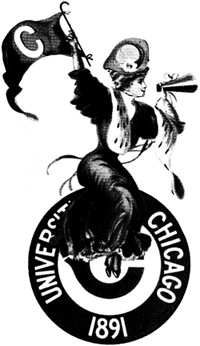|
||
     |
Peer Review ::
From our pages
1910 Concerned that Chicago cheerleading was “ineffective,” Frederick D. Nichols, class of 1897, exhorted a meeting of undergraduates to adopt a more “dignified” chant, according to the November 1910 issue. “During moments of excitement,” Nichols complained, cheers “become a rapid, hysterical conglomeration of noise, recognized by no one. ... Consequently Chicago’s rooting is considered a joke.” As a solution, he offered a slower chant of “Chi-ca-go, I will! Chi-ca-go, I will! Rah! Rah! Rah! Rah! Rah! Rah! I will! I will! I will! Chicago!” But proponents of the traditional “Chicago-Go” yell, in use since 1893, “criticized the new one as too funereal in tone.”
 1955
In a March 1955 essay, Maurice Crane, AM’50, reported that he had
“mixed the unmixable—good reading and television.” Based
in East Lansing, MI, Literature Unbound aired at 7:30 p.m. Monday,
Wednesday, and Friday, weekly featuring two works that “attack the
same problem, era, or story from different angles.” Initial combinations
included the Bhagavad Gita and the Koran, Arthur Koestler’s Darkness
at Noon and a biography of Lenin, and Christopher Morley’s Thunder
on the Left and J. D. Salinger’s Nine Stories. There was
some concern about supply for the TV audience: “These are all fine
books,” wrote Crane. “I can’t for the life of me understand
why none of them has found its way into any local drugstores.”
1955
In a March 1955 essay, Maurice Crane, AM’50, reported that he had
“mixed the unmixable—good reading and television.” Based
in East Lansing, MI, Literature Unbound aired at 7:30 p.m. Monday,
Wednesday, and Friday, weekly featuring two works that “attack the
same problem, era, or story from different angles.” Initial combinations
included the Bhagavad Gita and the Koran, Arthur Koestler’s Darkness
at Noon and a biography of Lenin, and Christopher Morley’s Thunder
on the Left and J. D. Salinger’s Nine Stories. There was
some concern about supply for the TV audience: “These are all fine
books,” wrote Crane. “I can’t for the life of me understand
why none of them has found its way into any local drugstores.”
1980 An extensive report from the Ad Hoc Commission on Alumni Affairs appeared in the Winter 1980 issue. Among other criticisms, the commission lamented that the Magazine “lacks distinction and suffers from a number of unflattering characteristics,” including little reader response, inconsistent character, uneven content, an absence of University and alumni news, irregular publication, and inadequate financing. To turn the publication around, former editor Felicia Antonelli Holton, AB’50, was brought back by President Hanna H. Gray, who remarked, “We want to have, quite simply, the best publication of its kind.”
1995 A reading roundup in the April issue featured “a bookcase full of potboilers, mysteries, satires—and even some great books” with a U of C backdrop. Jimmy’s, the C-bench, and Stagg Field, the Magazine noted, have all made cameo appearances in novels from Pearl Buck’s Command the Morning to Robert Pirsig’s Zen and the Art of Motorcycle Maintenance. In addition to the physical plant, some familiar faces have appeared in print. Fictional (and occasionally autobiographical) Chicago professors fall into a few predictable categories: “the emotionally draining, self-centered neurotic; the rumpled but lovable academic with strong appetites; the physicist with a heart; [and] the psychiatrist without one.”